June 23, 2016
The Comms team has used #the4thbox twice now with gathered groups of people and it’s had pretty astounding results. We find it is a helpful way to get people out of an intellectual space about equity, and into an imaginative space about the world we want.
Session 1: IISC Staff and Board Day
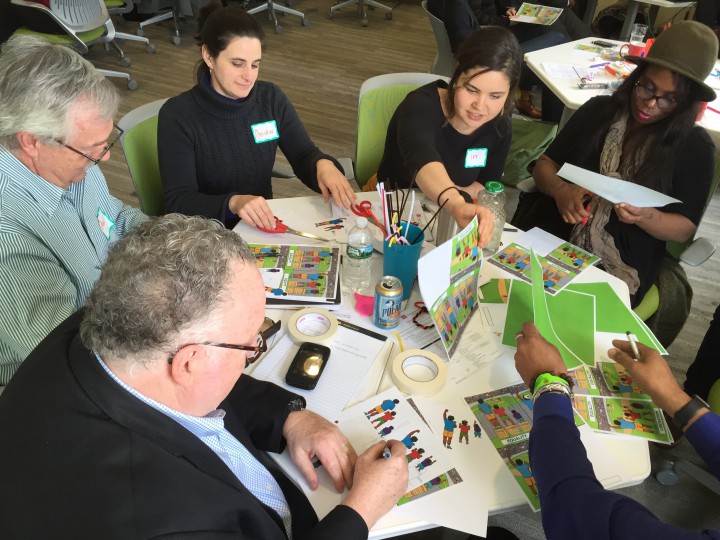
Our first use was at an IISC staff and board meeting. We were in the early stages of developing the cut-out kit with Angus Maguire and the Center for Story-based Strategy, and we used this moment to learn about user experience.
Read More
June 22, 2016
“We are caught in an inescapable network of mutuality, tied in a single garment of destiny. Whatever affects one directly, affects all indirectly. This is the interrelated structure of all reality.”
– Rev. Dr. Martin Luther King, Jr.
 That line is one my favorite lines from one of my favorite (probably my favorite) writing of Dr. King: Letter from Birmingham (City) Jail. It’s always resonated really strongly with me and it was also dated on my birth date, 16 April (I write and think about that speech often). Since I heard it, I’ve really tried to live believe it and feel it. I do genuinely think that deeply believing that idea is our (humans) only hope of getting out alive of the mess we’re creating of the planet and our societies.
That line is one my favorite lines from one of my favorite (probably my favorite) writing of Dr. King: Letter from Birmingham (City) Jail. It’s always resonated really strongly with me and it was also dated on my birth date, 16 April (I write and think about that speech often). Since I heard it, I’ve really tried to live believe it and feel it. I do genuinely think that deeply believing that idea is our (humans) only hope of getting out alive of the mess we’re creating of the planet and our societies.
Well, last week, I felt that interrelatedness in new way. Normally, I would keep stuff like this to myself, but I’ve found that sharing it has done more good than not. And since my colleague, Curtis Ogden, has introduced me to “thinking out loud,” I committed to start trying it. So here goes.
Read More
June 20, 2016

IISC Communications was ecstatic to partner with Food Solutions New England (FSNE) on the 2016 Racial Equity Challenge. IISC Comms is always trying to learn about how digital and analog interactions support each other. Given IISC’s mission “to create social justice and sustainability,” we know that both face-to-face conversations and online/digital conversations are needed. We also know that while many social change organizations are hesitant to engage in online spaces (it’s tricky, new, and the potential for backlash is high), for-profit corporations haven’t hesitated at all. In fact, they pay massive sums of money for online campaigning and research regarding how people interact with and consume digital content. Social change organizations don’t have near an equivalent amount of resources devoted to digital spaces to tip the conversation.
We saw an opportunity this Spring to join forces with FSNE’s Communications Coordinator, Johanna Rosen, to normalize conversations about race and racism. The group was hosting a second year of a 21-day Equity Habit Building Challenge. The challenge is a mix of sharing resources and sparking conversations in an effort to increase understanding about racial equity. FSNE is a network of food producers and community advocates, spread around the region with various levels of experience and access to digital media. What tools will best support this process, we asked? Read More
June 2, 2016
ATTENTION FRIENDS! Can you use the equality vs equity illustration in your book/video/presentation/etc?
Yes! You do not need written permission to reproduce the work. Read below for information on the license under which the illustrations are released.
Since releasing our adaptation of this cartoon in January (working with our dear artist friend, Angus Maguire), we’ve found other versions of it floating around the internet, either via word of mouth or direct contact. We hoped that by making the design files available we would get some clever renditions, but what we’ve seen has gone far beyond what we expected!
To keep track of them, we’ve started a gallery of the different riffs on the version for others to use. Take a look and if you see any others, please email them to comms@interactioninstitute.org or tag us on Twitter so we can add them to the gallery.
PS – Thanks, Andrea Nagel, for the supportive energy and prodding to get this out of my backlog and into reality.
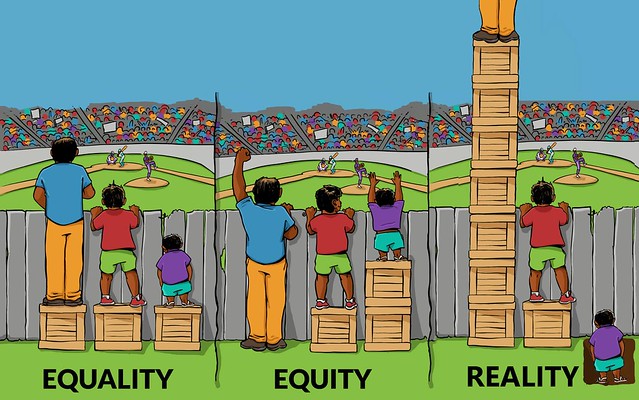
Created by Andrew and found on Facebook
Read More
April 10, 2016
On April 10, 2016, Food Solutions New England (FSNE) launches the 21-Day Racial Equity Habit Building Challenge with more than 600 participants who want to normalize the conversation about race and racism. IISC is a co-sponsor because we agree that skill building and conversations are key for collective capacity to identify and address the different manifestations of racism, whether internalized, interpersonal, institutional, or structural.
Do you want to grow, learn, and support racial equity? You can join here on the FSNE website.
You can also connect to this project on Facebook or by using the hashtag #FSNEEquityChallenge on Twitter.
IISC Senior Associate Curtis Ogden has been helping to weave FSNE’s network for over five years. He is a member of this year’s Racial Equity Habit Building team, which will include blogging about racial equity and promoting the conversation on social media. Additionally, IISC’s communications team, Lawrence Barriner II and Danielle Coates-Connor, have been supporting this year’s Racial Equity Habit Building Challenge with communications and engagement strategy.
=
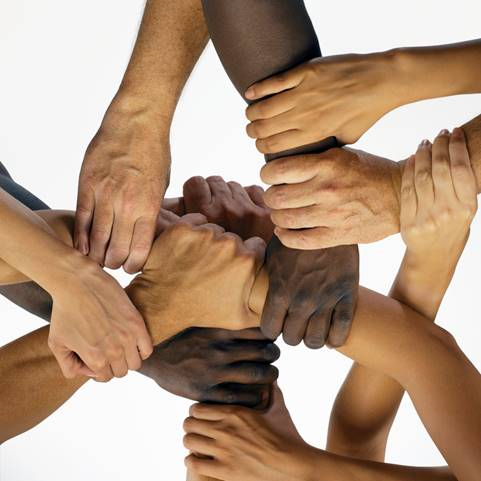
February 22, 2016
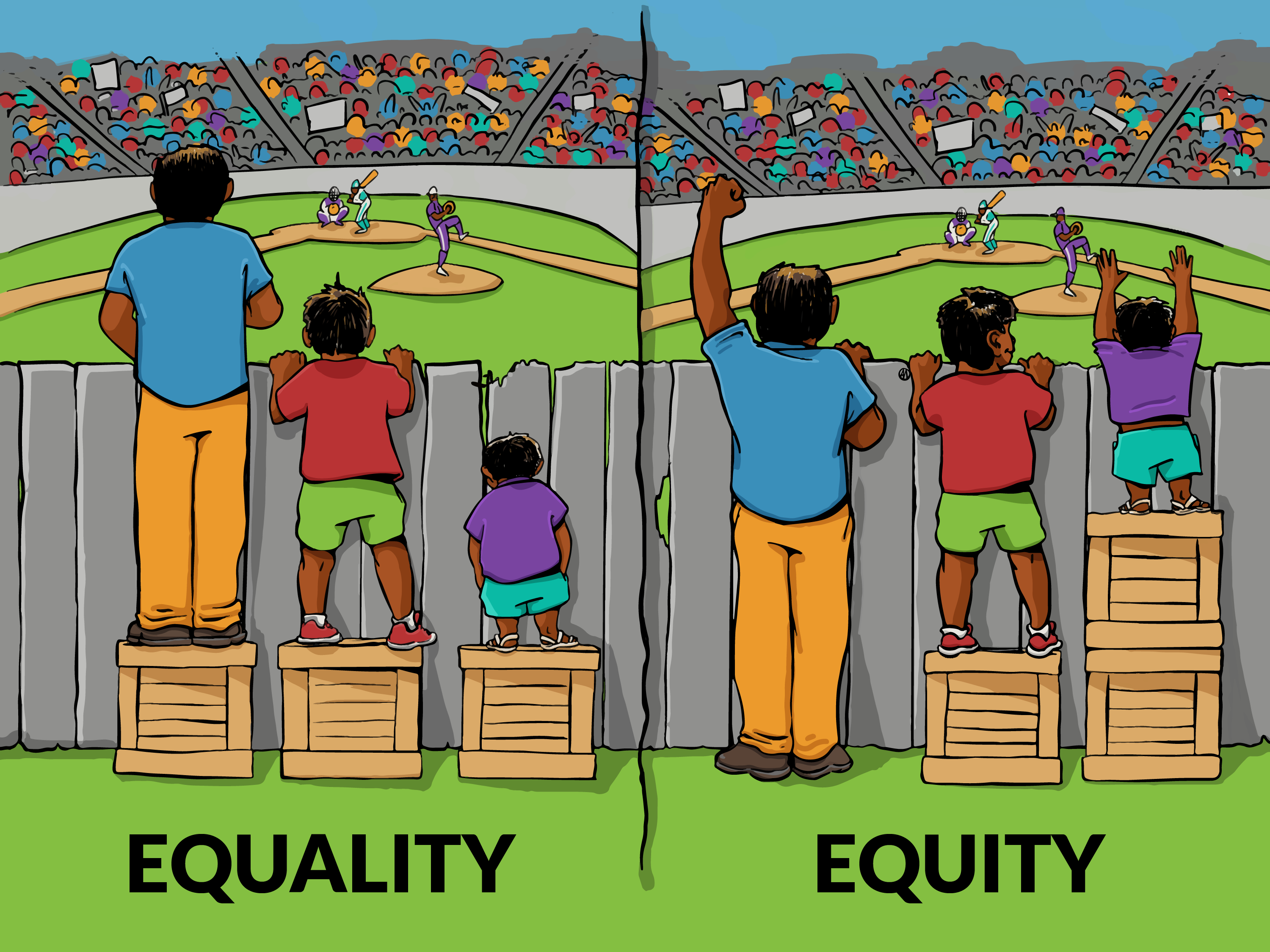
ATTENTION FRIENDS! Can you use the equality vs equity illustration in your book/video/presentation/etc?
Yes! You do not need written permission to reproduce the work. Read below for information on the license under which the illustrations are released.
In late 2015, Danielle and I collaborated with our friend and colleague, Angus Maguire, to produce the above adaptation of an old favorite (original blog post here). In the wake of the virality of the graphic on our social media channels, the three of us wanted to share a little of what we’ve been thinking since we released it into the wilds of the Internet a little over a month ago. – Lawrence
Lawrence: In all honesty, frustration was a primary driver of my interest in this project. I have seen this graphic in 15+ presentations and yet every time it seemed to be more pixelated than the last. I wanted our practitioners (and the world) to have a higher quality tool.
Angus: Collaborating with IISC on this little project was great. It wasn’t a complex project brief: essentially we set out to improve on the presentation of an internet classic. For me, it started as a great chance to experiment with a new illustration workflow – this is the first time I’ve done a cartoon like this digitally, start-to-finish. Software and hardware tools are now at a point where that’s possible for me, and I’m just getting started on the possibilities for experimentation and iteration.
Danielle: This image is popular because it creates an opening for more conversation. What works about it is that there are multiple points of entry. For the person who has never thought about equality or equity, they can see there is a difference, and begin to shift their thinking. Read More
January 18, 2016
First things first: shoutout to Coretta Scott King for founding the King Center in 1968. Without this institution, we would not have a national holiday celebrating her husband’s life and work.
For the past few years, in honor of Coretta’s wishes and Martin, I’ve been doing a little bit of self-education on Martin Luther King, Jr. Day. Last year, I discovered his speeches were on Spotify so I listened to about 4 hours worth. This year, I’m taking a long look at his Letter from a Birmingham Jail. (Coincidentally, the Letter has always been important to me because he wrote it on my birthday). Read More
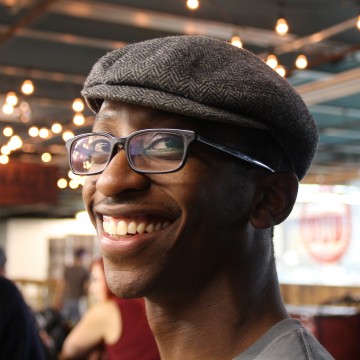
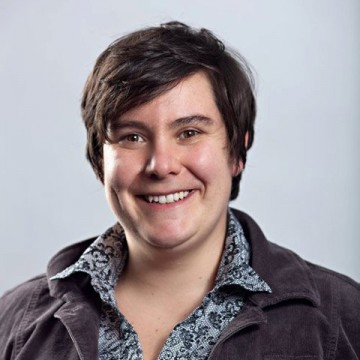

 That line is one my favorite lines from one of my favorite (probably my favorite) writing of Dr. King: Letter from Birmingham (City) Jail. It’s always resonated really strongly with me and it was also dated on my birth date, 16 April (
That line is one my favorite lines from one of my favorite (probably my favorite) writing of Dr. King: Letter from Birmingham (City) Jail. It’s always resonated really strongly with me and it was also dated on my birth date, 16 April (



